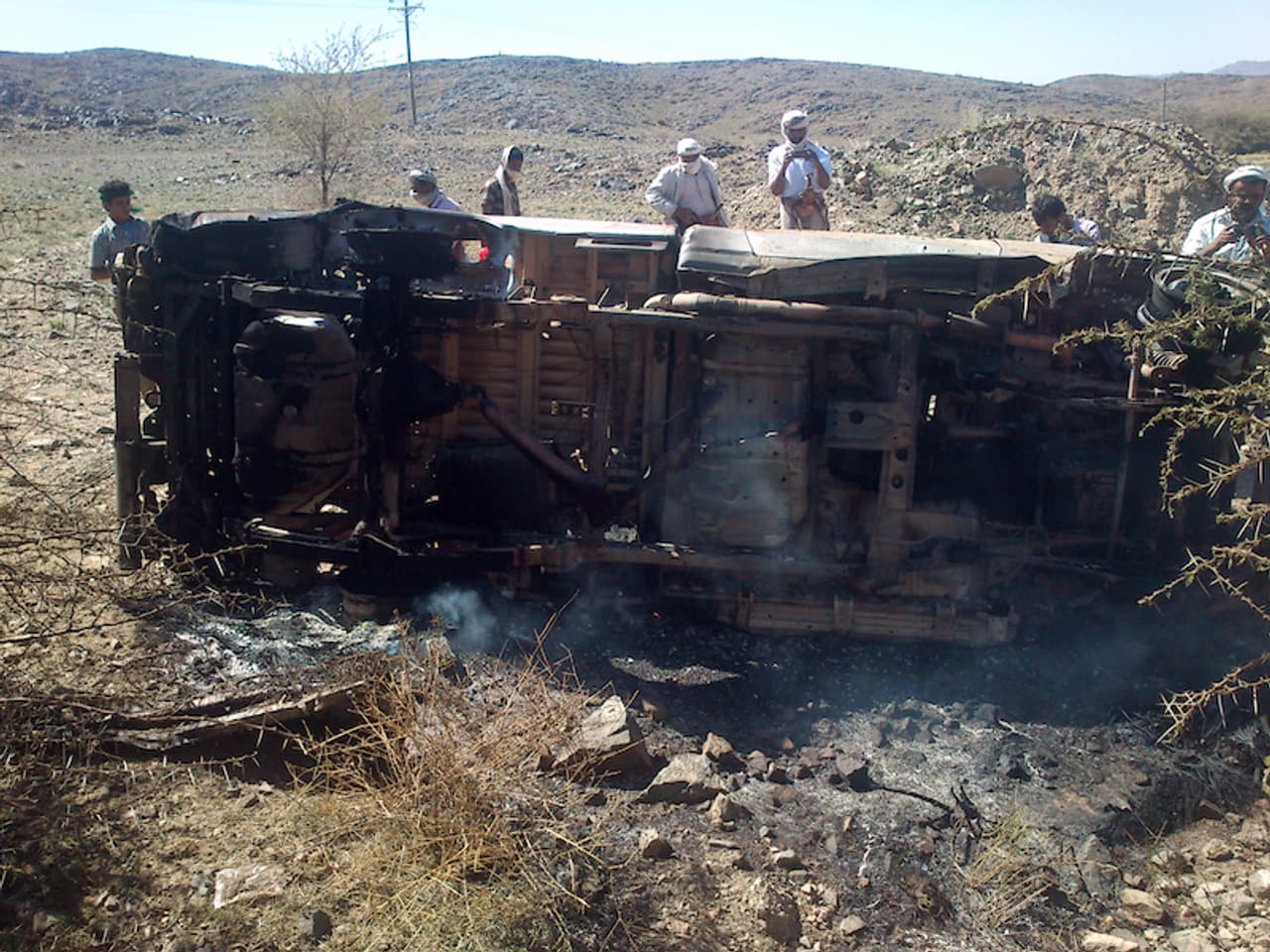
Bloodiest US and Yemeni attacks in two years kill at least 40 people
The smoking wreckage of one of vehicles hit in the CIA drone strike (EPA/STRINGER)
Three US and Yemeni attacks killed scores of people over the weekend in the bloodiest spate of strikes since March 2012.
At least two US drone strikes and a reported Yemeni special forces raid with US support, possibly also a drone strike, left at least 40 people dead. There were at least three civilians reported killed – only the second incident of confirmed civilian casualties this year.
The Yemeni Ministry of Interior said air strikes had killed dozens of suspected al Qaeda in the Arabian Peninsula (AQAP) militants, including several allegedly high-ranking militants.
‘The security authorities stated that the air strikes, which lasted for several hours, killed around 55 terrorists from [AQAP], including three movement leaders,’ the interior ministry said. Unnamed US officials told the New York Times CIA drones were used in the airstrikes. The CIA declined to comment when contacted by the Bureau.
Officials and eyewitnesses described how a US drone attacked a truck carrying alleged members of AQAP and also hit a vehicle carrying civilians in Yemen’s southeastern Al-Bayda Province on April 19.
Related story – US strike kills Australian and New Zealander in Yemen
At least 13 – and possibly as many as 21 – were reportedly killed in the attack, including at least three civilians. They were described as ‘construction workers‘ or ‘labourers’ by some reports. This is the highest death toll of any confirmed drone strike in Yemen so far this year.
The attack was reportedly based on ‘confirmed intelligence’ that the men were ‘planning to target vital civil and military institutions’.
Salem Nasser al Khashem, who said he was in the vehicle in which civilians were killed, described the attack: ‘While we were on the road linking al Sawmaa to the al Bayda city… a car was behind us. Suddenly, a rocket hit the car which was 15 meters away from us.’
‘When the car was hit, shrapnel reached our car. We had to get out and hide in a water ditch. However, the car kept on [burning] continuously for approximately an hour.’

The second attack occurred on Sunday when strikes targeted three suspected militant camps in the same province. A tribal source told Reuters 25 bodies had been removed from the site, while other media reported a death toll in excess of 30. The attacks were carried out by US drones and Yemen Air Force jets, Fares al Saqqaf, an advisor to Yemen’s President Abedrabbo Mansour Hadi, told Emirati newspaper.
The third in this series of operations against alleged militant positions in Yemen’s mountainous regions, an attack killed three people travelling in a car in Shabwa Province in the early hours of Monday April 21.
The Times reported that Yemeni troops ambushed a four-wheel drive vehicle and, after a gun battle, potentially killed a senior AQAP bombmaker, Ibrahim al-Asiri. Hadi reportedly sent a letter of congratulations to [the elite Counter-Terrorism Unit] and awarded medals for a ‘quality process against al Qaeda militants in Shabwa governorate.’
The New York Times reported US military personnel ‘had supported the Yemeni operations on the ground with intelligence and possibly logistical assistance’.
Local officials, a senior Yemeni official and a Yemeni military source all suggested a US drone had been involved in the operation that allegedly targeted Asiri, said to have been the mastermind behind the failed AQAP plot to blow up a US airliner on Christmas Day.
Hina Shamsi, American Civil Liberties Union
There were also unconfirmed reports that the joint US/Yemen operation in Shabwa had targeted AQAP leader Nasser al-Wuhayshi, who appeared in a video last month with dozens of supporters celebrating his organisation’s successful staging of a prison break in February.
Saqqaf told an Emirati newspaper that the operation over the weekend had been prompted by Wuhayshi’s sudden reappearance. US officials however cautioned that neither Wuhayshi nor Asiri were the target of the strikes.
These were the first US attacks since April 1, when it emerged that the US had stopped military drone strikes in Yemen, following a catastrophic strike in December 2013 in which up to 12 reported civilians in a wedding party were killed.
In May 2013, President Obama said in a major policy speech on targeted killings: ‘Before any strike is taken, there must be near-certainty that no civilians will be killed or injured.’ He described this as ’the highest standard that we can set’.
Related story: Yemen: Reported US covert actions 2014
‘If true, the reports of civilian casualties once again raise serious questions about whether the United States is following President Obama’s policy that the US only strikes when it has “near-certainty” that no civilians will be harmed,’ said Letta Tayler, counter-terrorism researcher at Human Rights Watch. She told the Bureau: ‘The US needs to explain whether it made a tragic error or whether it willfully ignored this policy and if so, why.’
Hina Shamsi of the American Civil Liberties Union, which has brought cases over US drone strikes in Yemen, told the Bureau: ‘If the targets of the latest drone strike were lawful – and we don’t know that for sure – it’s hard to see why the strike couldn’t take place after a car full of civilians was out of danger.’
Yemeni journalist Nasser Arabyee said the attacks ‘confirmed the US [has] resumed its drone war’ on AQAP in Yemen.
Follow Patrick Galey, Jack Serle and Alice Ross on Twitter. Sign up for the drones newsletter and subscribe to the podcast.


